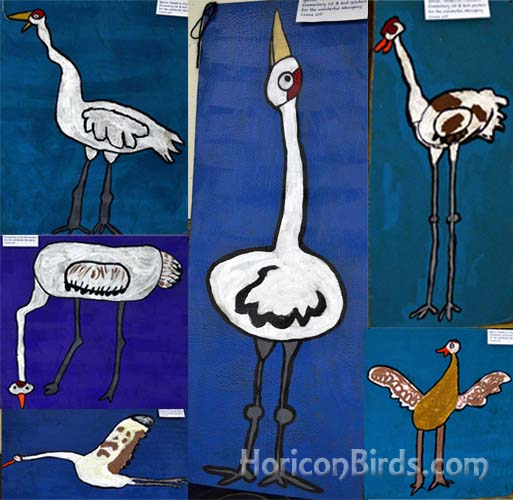|
Whooping Crane Festival 2013
by Pam Rotella
24 September 2013
HoriconBirds.com
USGS counts 575 whooping cranes alive today
Only 575 whooping cranes are alive today, according to Research Wildlife Biologist John French of the USGS Patuxent Wildlife Research Center. This is a slight decline from the previous count of 600.
Speaking at Operation Migration's 2013 Whooping Crane Festival, French said 275 whooping cranes were counted in the wild Wood Buffalo/Aransas western migratory flock, 160 in captive breeding flocks, 100 in the Eastern migratory flock, 20 in Florida's non-migratory flock, and 18 in Louisiana's non-migratory flock.
French discussed the importance of the Eastern experimental flock, and cited southern habitat challenges to the wild Aransas/Wood Buffalo flock such as drought, rising human water consumption, close proximity to Gulf shipping lanes, and river level fluctuations affecting their preferred Aransas food source, small blue crabs. He also described Patuxent's captive breeding program in detail.
According to French, Patuxent's captive breeding program stopped adding crane chicks to the non-migratory Florida flock about eight years ago. Natural predators were reducing the flock's numbers, and human development was reducing its habitat.
French added that Patuxent remains committed to increasing the Louisiana non-migratory flock and the Eastern migratory flock, but acknowledged criticism of their decision to provide more captive-bred chicks to the non-migratory Louisiana flock, which has faced a drop in numbers from shootings and natural predators.
Galapagos finches near extinction from invasive species
Galapagos finches are famous among biologists as the inspiration for Darwin's theory of natural selection. Now one of those finch species has become endangered from an invasive species, according to entomologist Michelle Taliaferro of Auburn University at Montgomery.
Taliaferro participated in an Earthwatch research project to study the impact of Philornis downsi, a parasitic fly, on the Medium Tree Finch.
According to Taliaferro, "...These are parasites, the larval stage of the fly, because they feed upon the tissue and also the blood of the hatchling birds. They've had up to 100% mortality in some of these nests, and one of the tree finches, the medium tree finch, [is a] critically endangered species found only on one island -- the island of Floreana, which is where we did the work when I was there. And so, there are only about 1,500 medium tree finches that exist on this one island of Floreana in the Galapagos."
Philornis downsi is an invasive species to the island. Adult Philornis downsi flies feed on fermenting fruit, but its larvae prey upon finch chicks. According to Taliaferro, adult flies lay their eggs on finch chicks and nests at night while adult finches are away. The fly maggots then hatch and consume the chicks, often killing or deforming them.
Taliaferro said that scientists have noticed some changes in finch behavior to evade the flies. For example, some female finches are mating with smaller finches of a different species that build smaller nests, while experienced adult males have learned to conceal their nests better. Research continues on potential solutions to the infestation.
Joe Duff of Operation Migration
Joe Duff, co-founder and lead pilot of Operation Migration, covered the training of captive-bred whooping cranes for the birds' first migration south.
"The idea is really not to look like a bird; it's to disguise the human form," Duff said of the costumes used to rear the cranes, explaining that they don't want whooping cranes living in peoples' backyards, seeing humans as a food source, or looking to humans for mates. Duff also covered the challenges of building new enclosures and a runway at White River Marsh Wildlife Area. The move was designed to protect new chicks from black fly infestations and nesting difficulties experienced by older cranes at Necedah National Wildlife Refuge, the previous training site.
Duff said that whooping cranes assigned to Operation Migration this year are destined for St. Marks National Wildlife Refuge in Florida.
The organization will also acquire new airplanes next year, and the fleet will be maintained by mechanics, according to Duff -- a new FAA requirement following the agency's famous delay of the group's 2011 migration. The 2011 delay ultimately resulted in the cranes' release at Wheeler National Wildlife Refuge in Alabama instead of their original Florida destination.
Festival fun for bird watchers
 The Whooping Crane Festival offered several talks and activities for bird watchers.
The Whooping Crane Festival offered several talks and activities for bird watchers.
Pat Fisher opened the Saturday event with live birds rescued by the Feather Rehabilitation Center (pictured below with a turkey vulture). Tom Schultz of the Wisconsin Society for Ornithology spoke about birding at White River Marsh, and conservationist and author Kenn Kaufman spoke at a dinner on Friday.
The Berlin Conservation Club was adorned with whooping crane artwork from Princeton Elementary's first and second grade classes (pictured to the right).
Festival-goers could also enjoy a guided group tour of the International Crane Foundation in Baraboo, Wisconsin on Sunday.
Teacher Sarah Geisthardt's first and second grade students from Princeton Public Schools read from Eileen Spinelli's book "Song for the Whooping Crane" (pictured below).
Craniacs gather roadside to watch flight training
Whooping crane enthusiasts, who sometimes refer to themselves as "craniacs," gathered early mornings before the festival to watch whooping cranes follow Operation Migration's ultra-light pilots. Cranes training at White River Marsh are destined for the Eastern Migratory Flock.
Initially the young cranes' training occurs close to the ground and is not visible from the road. As the birds grow stronger and migration time approaches, the cranes are trained higher in the air, and are visible from a highway near the cranes' enclosure.
While weather conditions caused some training cancellations and delays, crane watchers saw the young cranes fly on Friday, Saturday, and Monday mornings of the festival weekend.
Operation Migration is planning to begin its 2013 migration at the end of September, the exact date to be determined as weather conditions unfold.
All original content including photographs © 2013 by Pam Rotella.
|